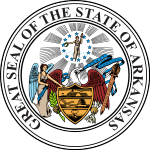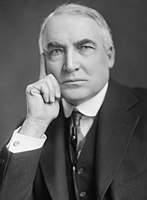| ||||||||||||||||||||||||||
| ||||||||||||||||||||||||||
 County Results
| ||||||||||||||||||||||||||
| ||||||||||||||||||||||||||
| Elections in Arkansas |
|---|
 |
The 1920 United States presidential election in Arkansas took place on November 2, 1920, as part of the 1920 United States presidential election in which all 48 states participated. State voters chose nine electors to represent them in the Electoral College via a popular vote pitting Democratic nominee James M. Cox and his running mate, Assistant Secretary of the Navy Franklin Roosevelt, against Republican challenger U.S. Senator Warren G. Harding and his running mate, Governor Calvin Coolidge.
Except for the Unionist Ozark counties of Newton and Searcy where Republicans controlled local government, Arkansas since the end of Reconstruction had been a classic one-party Democratic “Solid South” state.[1] Disfranchisement during the 1890s of effectively all blacks and most poor whites had meant that outside those two aberrant counties, the Republican Party was completely moribund and Democratic primaries the only competitive elections. Although the northwest of the state was to develop a strong Socialist Party movement that served as a swing vote in county elections,[2] political repression[3] and internal party divisions[4] diminished that party's strength substantially.
The Democratic Party, under the influence of future federal Senate Minority and Majority Leader Joseph Taylor Robinson and demagogic Governor and Senator Jeff Davis, was to make many familiar progressive changes in railroad regulation and child labor,[5] but under the administration of George W. Donaghey – who saw his administration and Democratic primary candidacy as a fight against the “Davis Machine”[6] – more rapid development occurred, especially in abolishing convict leasing and improving bank regulation.[7]
The aftermath of World War I, however, made for a temporary turn in Arkansas voter allegiances. The League of Nations was to be spurned in the isolationist and fundamentalist[8] Ozark region,[9] and outgoing President Woodrow Wilson was thus stigmatised for his advocacy of that organization. New Democratic nominee James M. Cox also supported American participation in the League,[10] whereas his rival Warren Harding was largely opposed to the League and was helped in the South by racial and labor unrest elsewhere in the country.[11]
Despite this, the solid Democratic majority of Arkansas was always conceded by polls across the nation at the end of October, even as the possibility of Harding breaking the “Solid South” was seen in Tennessee and even North Carolina.[12] In culmination, Cox won the election in Arkansas with 58.05 percent of the vote; Harding received 39.15 percent of the vote and the only other candidate on the ballot, imprisoned Socialist Eugene Debs received the remaining 2.80 percent. Harding’s result was nonetheless a major improvement upon the mere 28 percent won by Charles Evans Hughes in 1916, and rivaled any Republican performance in the state since the advent of the poll tax, although Theodore Roosevelt in 1904 had done marginally better. Harding was the first Republican to ever carry Van Buren County,[13] the first to carry Logan County since Ulysses S. Grant in 1872,[13] and the first Republican since Benjamin Harrison to carry Arkansas County and Lincoln County.[13]
- ^ See Urwin, Cathy Kunzinger. Agenda for Reform: Winthrop Rockefeller as Governor of Arkansas, 1967-71. p. 32. ISBN 1557282005.
- ^ Reed, Roy. Faubus: the Life and Times of American Prodigal. p. 32. ISBN 1610751485.
- ^ Green, James R. (July 1978). Apocalypse and the Millennium in the American Civil War Era: Radical Movements in the Southwest, 1895-1943. LSU Press. pp. 316–318. ISBN 0807107735.
- ^ Reed. Faubus, p. 33
- ^ Moneyhon, Carl H. Arkansas and the New South: 1874-1929. p. 121. ISBN 1610750284.
- ^ Moneyhon. Arkansas and the New South, p. 122
- ^ Whayne, Jeannie M.; DeBlack, Thomas A.; Sabo, George; Arnold, Morris S. (June 2013). Arkansas: A Narrative History. University of Arkansas Press. p. 302. ISBN 978-1557289933.
- ^ Ruotsila, Markku (2003). "Conservative American Protestantism in the League of Nations controversy". Church History. 72 (3): 593–616. doi:10.1017/S000964070010037X.
- ^ Phillips, Kevin P. (November 23, 2014). The Emerging Republican Majority. Princeton University Press. p. 211. ISBN 9780691163246.
- ^ Faykosh, Joseph D. (2016). A party in peril: Franklin Roosevelt, the Democratic Party, and the Circular Letter of 1924 (Thesis). Bowling Green State University. p. 43.
- ^ Faykosh. A Party in Peril (Thesis) p. 42
- ^ "Victory is Claimed by Rival Chairmen: Hays Sees 368 Electoral Votes for Harding". The Washington Post. October 31, 1920. p. 1.
- ^ a b c Menendez, Albert J. (2005). The Geography of Presidential Elections in the United States, 1868-2004. Jefferson, North Carolina: McFarland & Company. pp. 148–151. ISBN 9780786422173.


